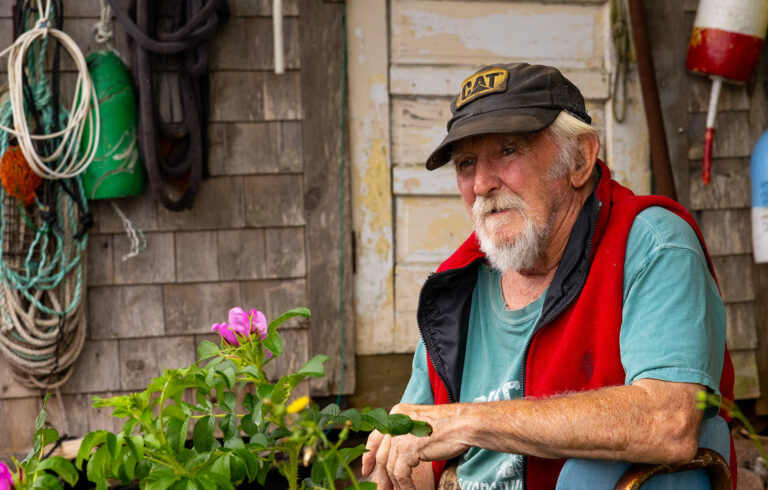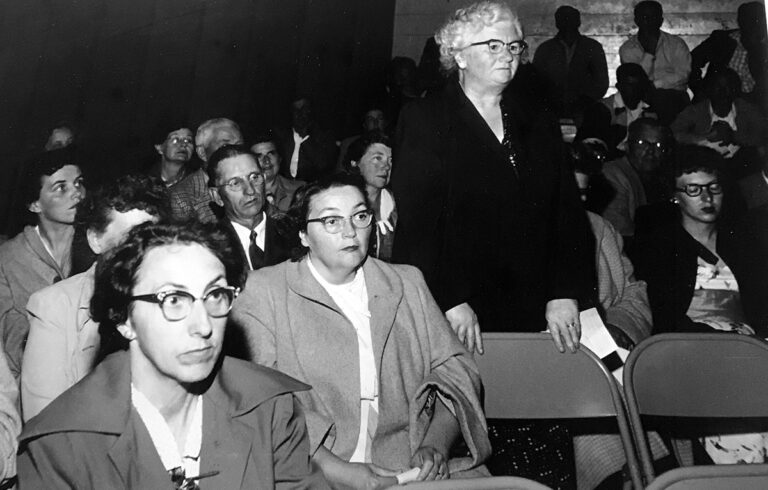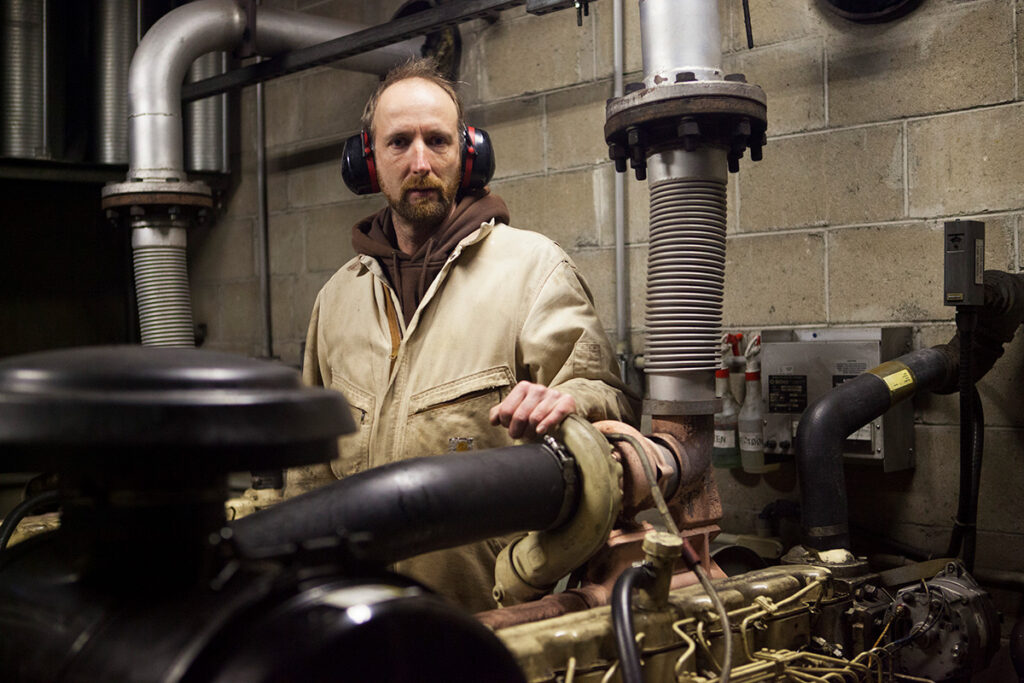
There’s a joke on Monhegan that the name of the island can be loosely translated as “island of many waitresses.” Like the hundreds of 20-something women that have preceded me, I showed up on this rock to wait tables after finishing college. In between polishing glassware and reciting the daily specials, I got a glimpse into life out at sea and some firsthand experience with how things that are taken for granted on the mainland—like keeping the lights on—are much more complicated on an island.
A busy August night at the restaurant serves as an example. The clatter of the kitchen crew, Norah Jones on the CD changer, and the echo of questions about “life in the winter” served as a backdrop to the hustle and bustle of dinner service as we brought out plate after plate of boiled lobster and stuffed haddock. And then just like that: silence. The power was out.
By this point in the season, the response was a well-choreographed dance. The cooks strapped on head lamps and brought out camping lights. The dining-room manager added more candles to the tables so that guests could see their meals. The wait staff worked to keep the guests calm and comfortable, picking up the plates of food as quickly as possible from the cooks, who had begun cursing about the fiery heat that was now consuming the unventilated kitchen. Finally, the sound we were all waiting for: the unmistakable muffler of Chris Smith’s truck, signaling that help was on the way.
Chris had just left the inn where I was working and where he serves as the caretaker when he’s not out fishing or taking on carpentry jobs. Rather than relaxing at home, he was now on his way back through town, headed up to the power station to check on the diesel generators that power Monhegan’s grid. Within about 15 minutes, the lights came back on and we heard the roar of the kitchen fans starting back up. The guests settled back into their meals and chuckled about how this would add to the memorable experience of going “back in time” on Monhegan Island.
Chris Smith is the plant manager for the Monhegan Plantation Power District (MPPD). With more than 10 years of managing the 300-kilowatt power station atop Lighthouse Hill, he could fill a scrapbook with his own “memorable moments.” Calls from the generator station during his college roommate’s wedding ceremony. Cycling power service between different parts of the island when the big generator had shut down during the busy summer season. The headaches of trying to get a set of new transformers to the island that had been stuck in Port Clyde. And the familiar post-power-outage sight of summer visitors lining the sides of Monhegan’s dirt roads, eager to ask him why the power is out as he makes his way to the power station. While he doesn’t always love it, these are the experiences that make him a member of an exclusive club of modern-day lighthouse keepers on New England’s most remote, diesel-powered islands.
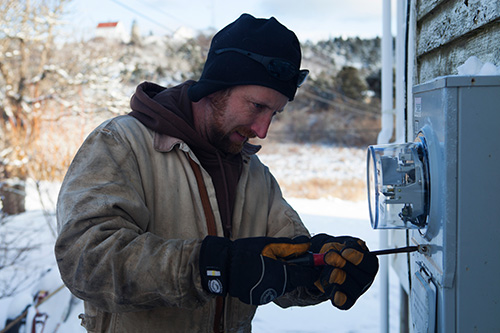
Keeping the power on has been no small feat for Chris and the rest of MPPD since the quasi-municipal electric utility was incorporated in 1999 to serve the island’s approximately 120 ratepayers. The private power company that had been started in the 1980s was in the process of being shut down by state regulators, because the diesel generators had been operating right next to the island’s drinking-water aquifer. In order to avoid disruption to service, islanders had to act quickly, pulling off the construction of a relocated power station on a shoestring budget.
The challenges were only just beginning, though; shortly after the project was completed, Chris started to notice problems with the switchgear, the piece of equipment that automates the ability of the station’s three generators to seamlessly match the island’s demand. Not long after the one-year warranty had expired, the company that manufactured the parts had gone bankrupt, and a critical component of MPPD’s operations became obsolete. With no service or ability to easily purchase parts, Chris and Marian Chioffi, MPPD’s book-keeper, were left with few options other than to scour eBay and other corners of the Internet for parts, which ultimately proved too expensive for a new power company struggling to make ends meet.
The system continued to prove unreliable, with outages such as the ones I experienced in the restaurant occurring on a somewhat regular basis. Chris and the others that keep watch over the power station and buried power lines have been able to keep the outages brief compared to mainland standards, but as the technical glitches became part of MPPD’s reality, a new challenge emerged. The price of diesel continued to creep up during the mid-2000s.
Eventually, MPPD was forced to increase rates from 55 cents per kilowatt-hour (kWh) to 70 cents/kWh in 2008.
Seventy cents/kWh. At more than four times what we pay on the mainland in Maine, the figure routinely elicits gasps. While it can be true that “it’s lonely at the top,” Monhegan is not without peers when it comes to the outer islands of New England.
Paul Murray of the Matinicus Plantation Electric Company (MPE) runs a town-owned diesel power company that serves about the same number of customers and has similar rates to those of MPPD. Paul followed in his father’s footsteps when he began working with MPE in the late 1970s, and has served as station operator since 2000. His stories are largely of how dedicated staff and community cooperation have helped MPE to create a system that works for Matinicus—at least from a technical point of view.
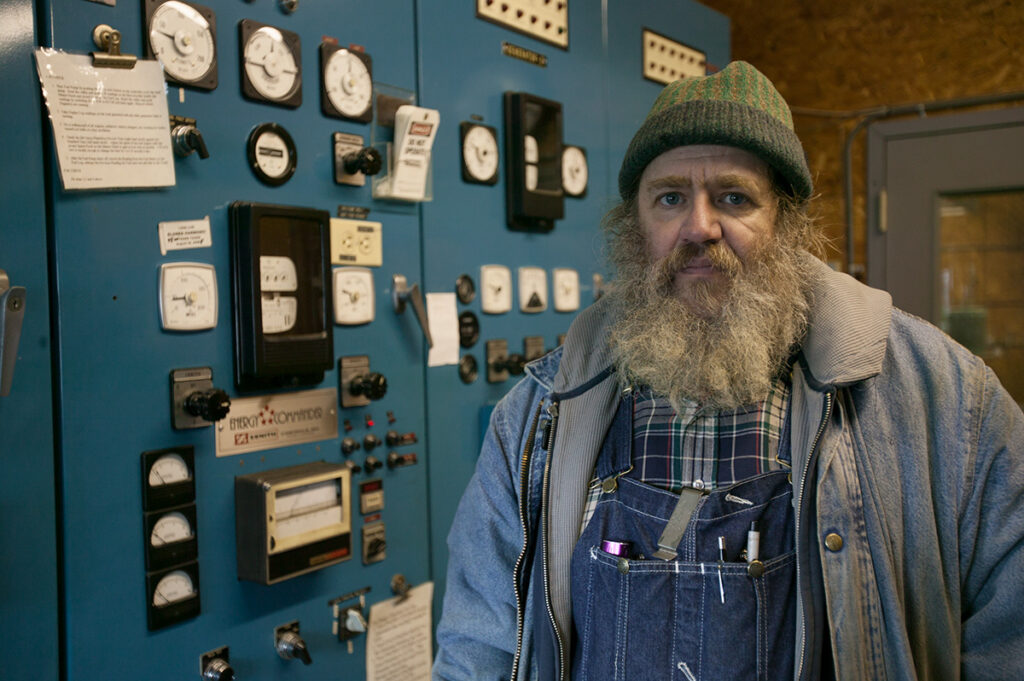
According to Paul, MPE’s secret sauce is based in the power station’s equipment. “The generators are generally pretty simple. They’re older technology—generators with two-cycle engines which are a lot less efficient but are easier to maintain—and the switchgear is pretty straightforward: It’s circuit breakers, relays, and meters, basically, so it doesn’t take a full electrical engineering degree to troubleshoot it. So we’re lucky in that way.” It has also helped that Paul has a reputation of being resourceful, and, with his signature blue overalls, he’s not afraid to get his hands dirty. Over time, he and his predecessors have tinkered with the system to customize it to their needs.
When there are problems with service on the island, strong support from his community is what helps to keep the lights on. According to Paul, islanders do their part to help keep things running smoothly, and have learned how to help with outages while staying safe over the years.
When there’s an issue at the power station, an alarm system is programmed to call Paul’s home phone and his pager. As on Monhegan, people on Matinicus also know how to track Paul down when the lights go out. In some cases, islanders will call him at home, even in the middle of the night—something that Paul encourages, as it can help him to troubleshoot the issue faster.
In other cases, they seek him out. Paul recounted a recent outage during a storm that hit around the 2012 holidays. “I was headed to the powerhouse because it had dumped the whole island. By the time I got to the powerhouse, John Griffin was already there to tell me that the tree across the street from his house was down on the line.” Paul said he wouldn’t put power back on before he checked things out at the powerhouse and the tree had been moved, so John told him he was going to put together a crew to start clearing. “By the time I could get up there to help, he already had a crew of five or six guys.”
As mainland utilities spend millions of dollars to upgrade to a 21st-century “smart grid” that enables them to troubleshoot service problems remotely, it seems that the electric grid on Matinicus is already smart enough, even without the bells and whistles, thank you very much. But with electric rates currently close to 70 cents/kWh, Paul sees high costs as a more pressing challenge for the future of electricity on his island.
About 100 miles to the southwest of Monhegan on Star Island, in New Hampshire’s Isles of Shoals, Jack Farrell cracks a smile when he recounts his own story of silence. Early in his first season as facilities manager, he woke early on a beautiful May morning to hear the waves crashing against the rocks and the seagulls flying overhead. “I thought, ‘Isn’t this job amazing; this is what I get to wake up to.’ Then I realized it was because the engines had shut down, and I had to go running out the door to see what was going on.”
Jack first began working on Star in 2009, and, as is typical for hard workers on islands, his job description quickly broadened from providing sailboat charters for guests to running the supply boat, then working in the power station as facilities manager, and now, overseeing all island operations as island manager. An active fishing outpost in the 1700s, Star Island has served as a summer conference center with a deeply devoted following since the late 1800s. Many visitors to the island—referred to as “conferees”—have been coming for decades, and are considered more than just guests. Says Jack: “Star Island is a family.”
Fortunately for Jack, that mentality has carried over into maintaining the island. Longtime conferees and their families often end up helping with the island’s operations as committee members or staff. For instance, Marshall Frye, the current island engineer, has been coming as a conferee since he was a young boy, working his way up the maintenance ranks. “He’s a terrific, smart, hardworking, reliable guy,” says Jack. “Without people like that, we just couldn’t operate.”
Jack and Marshall, along with a team of summer workers, keep busy on the island. Because Star is run as a large facility that can sleep about 400 people a night, Jack and his team approach the island as a system, complementing Jack’s knack for big-picture thinking. The island’s biggest power uses relate to water—a reverse-osmosis system to produce drinking water, a pumping system to store water, and a wastewater-treatment facility—so these systems easily find themselves in the crosshairs of efforts to reduce the use of diesel on the island. As a result, water use is strictly limited during a conferee’s stay.
According to Jack, most conferees accept Star’s energy-saving measures as part of the experience, but they do raise some concerns. “Our conferees are really dedicated and committed to Star—they’ve grown up with diesel, and understand the limitations—but as we try to gain new conferees and expand our appeal, we’re constantly faced with people coming out and saying, ‘How come there’s no electric outlet in my room?’ ”
While the technical challenges of running the outer-island power stations can be confounding, it’s the price of diesel that has been the 800-pound gorilla for much of the past decade.
Each island deals with the cost differently. On Matinicus, the first dollar per gallon of fuel is built into the rate, but anything beyond a dollar is paid for with a fuel surcharge assessed on each customer. In recent years, this has crept up, where the fuel charge is the highest component of the bill. In 2011 on Star, a small fuel surcharge was added to the nightly rate of the hotel, although it was recently removed when it proved unpopular with conferees. On Monhegan, the high price of fuel in the summer of 2008 created a crisis where the island’s largest users were being asked to pay in advance of the due date so that MPPD could keep buying diesel.
It’s not uncommon for cash-flow issues to keep power-company folks up at night, wondering if they’ll have the money they need when the fuel boat arrives. Marian Chioffi has been in that position since she started as MPPD’s bookkeeper in 2004. Over the years, she has mastered the creative accounting necessary to manage MPPD’s seasonal cash flow, making 3 months of high revenues stretch over 12 months of expenses. Like most of the island power companies, MPPD’s financial situation is further strained by unpaid bills. Marian explains: “Because it’s a tiny place you have to carry your neighbors. You can’t get money if they don’t have money.” Searching for an alternative, Marian joined the Island Institute’s Island Sustainability through Leadership and Entrepreneurship (ISLE) program in 2012. This initiative will provide her some support in updating MPPD’s business plan and developing strategies to lower MPPD’s costs, such as increasing the availability of CFL and LED lighting on the island.
The stories are repeated as you travel farther down the coast. In Massachusetts, Wayne Perrier keeps watch over Cuttyhunk’s diesel-generator fleet, rarely traveling far from the island because of the potential for technical glitches. On neighboring Naushon, longtime summer residents paid $1/kWh before a series of recent efforts by Paul Elias and his team to lower energy costs. Even on Block Island in Rhode Island, where the population can swell to more than 10,000 in the summer, the community has long struggled with its dependency on costly diesel.
After the economic crash of 2008 took its toll on global energy markets, islanders were provided some relief, but diesel prices have been on a steady march upward ever since. To complicate matters, the current glut of natural gas that has cut electric rates on the mainland will do little to alleviate the stress of high energy costs on the outer islands in the absence of a cost-effective way for these communities to access it. Instead, there’s a consensus that fuel prices will continue to creep up. “We all know it’s coming,” says Chris Smith. There’s also a consensus that it’s time to start planning for a different energy future.
The year 2013 will be a turning point. Island-based efforts are garnering the attention of federal agencies, including the US Department of Agriculture (USDA) and its Rural Development program, the US Environmental Protection Agency (EPA), and the US Department of Energy (DOE). It seems as if New England’s outer islands are so far at the edges of our nation’s energy challenges that they might just end up as leaders in demonstrating solutions.
There’s an inventive spirit on Matinicus, driven by Paul Murray and Matinicus Town Assessor Clayton Philbrook’s willingness to try things out and get their hands dirty. Along with a few lobstermen on the island, they have been experimenting with a supplemental hydrogen generator to cut fuel use over the past year, and are now looking to use an EPA grant to upgrade to four-cycle engines, which could lead to a 30 percent improvement in fuel efficiency. A new hybrid technology could extend the savings by 25 percent, thanks to an efficient storage system. “That’s a big deal,” says Murray. “While we’re taking it slow to look at our options, it hurts a lot to still be paying for the fuel. The sooner we can reduce our use of diesel, the better we’re going to like it.”
After years of discussing small wind projects, Cuttyhunk and Monhegan are ready to embrace the power of the sun. A special High Energy Cost Grant from the USDA is enabling both islands to install solar projects this year—a modest one on Monhegan, and a larger one on Cuttyhunk. The Monhegan grant will also cover the costs of the long-overdue replacement of the antiquated switchgear and purchasing a smaller generator that will more efficiently cover the winter load.
Monhegan can’t entirely escape discussions about wind power, as a DOE-backed team from the University of Maine is hard at work, preparing to test a one-eighth-scale floating turbine in the R&D demonstration area that has been designated two miles to the south of the island. When news came in December 2012 that additional DOE funding was on its way, the university team raised the possibility of testing much larger turbines in the area and running a submarine cable to power Monhegan. Fortunately, Monhegan leaders can gain some insight from Kim Gaffett and others on Block Island, where they are finalizing agreements about a cable that will run to the island from an offshore wind project that is anticipated to begin construction in 2014.
Star Island is taking perhaps the most comprehensive approach this year, borrowing a page from the book that Naushon is writing with its new hybrid diesel-solar system and massive battery bank. As both islands are governed centrally, they are able to swiftly make broad decisions about their futures. This has enabled Jack and Star’s Board of Directors to craft a plan that will almost entirely eliminate the use of diesel through a redesign of their water systems and a large-scale solar project that is on track to begin operating in 2014. While some have questioned the scale of the planned changes, Jack has remained steadfast in his mission to wean Star off of its diesel addiction.
Like most challenges on an island, it takes a community to get things done. Each member of the power-station crew will tell you how their volunteer board members, replacement staff, summer residents, fuel-delivery guys, and service technicians are critical to keeping the lights on. But it’s hard to miss the dedication and resourcefulness of the power-station operators and their role in building the energy future of their islands, even with their self-effacing nature.
The islanders are also learning that they’re not alone. An annual Island Energy Conference—hosted by the Island Institute—has been convening the power companies since 2010, creating a space to talk shop, share what works, and build a sense of camaraderie.
“We’re all completely in the same boat,” Chris says. “We’re all dependent on diesel fuel; we all have to make do with what we’ve got. These guys,” he says, referring to all the pragmatic islanders keeping the generators humming, “are a bunch of MacGyvers.”


